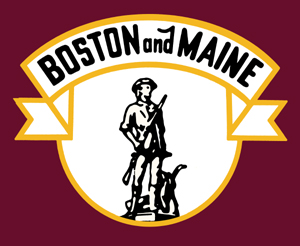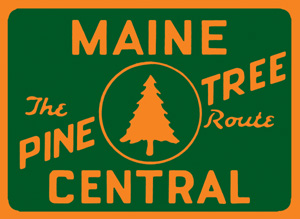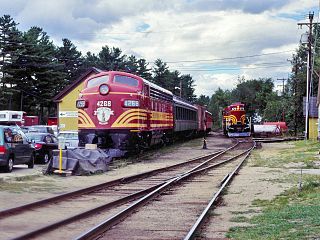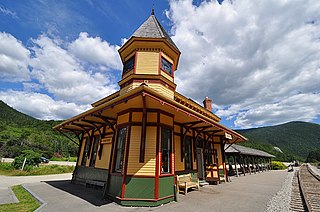
The Boston and Maine Railroad was a U.S. Class I railroad in northern New England. Originally chartered in 1835, it became part of what was the Pan Am Railways network in 1983.

The New York, New Haven and Hartford Railroad, commonly known as The Consolidated, or simply as the New Haven, was a railroad that operated principally in the New England region of the United States from 1872 to December 31, 1968. Founded by the merger of the New York and New Haven and Hartford and New Haven railroads, the company had near-total dominance of railroad traffic in Southern New England for the first half of the 20th century.

The Mount Washington Cog Railway, also known as the Cog, is the world's first mountain-climbing cog railway. The railway climbs Mount Washington in New Hampshire, United States. It uses a Marsh rack system and both steam and biodiesel-powered locomotives to carry tourists to the top of the mountain. Its track is built to a 4 ft 8 in gauge, which is technically a narrow gauge, as it is 1⁄2 inch (13 mm) less than a 4 ft 8+1⁄2 instandard gauge.

A streamliner is a vehicle incorporating streamlining in a shape providing reduced air resistance. The term is applied to high-speed railway trainsets of the 1930s to 1950s, and to their successor "bullet trains". Less commonly, the term is applied to fully faired upright and recumbent bicycles. As part of the Streamline Moderne trend, the term was applied to passenger cars, trucks, and other types of light-, medium-, or heavy-duty vehicles, but now vehicle streamlining is so prevalent that it is not an outstanding characteristic. In land speed racing, it is a term applied to the long, slender, custom built, high-speed vehicles with enclosed wheels.

The Lake Shore Limited is an overnight passenger train operated by Amtrak between Chicago and the Northeastern United States, with sections to New York City and Boston. The central segment of the route runs along the southern shore of Lake Erie. East of Chicago, the Lake Shore Limited follows the former main line of the Lake Shore and Michigan Southern Railway to South Bend, Toledo, Cleveland, and Buffalo. From here the train takes the Empire Corridor through Rochester and Syracuse to Albany–Rensselaer station in Rensselaer, New York. At that station, the train divides, with one section continuing to Springfield and Boston in Massachusetts, while the other continues along the Empire Corridor to New York City. The train is scheduled for 19+1⁄2–20+1⁄4 hours for the 959 miles (1,543 km) between Chicago and New York, and 21+1⁄2–22 hours for the 1,018 miles (1,638 km) between Chicago and Boston.

U.S. Route 302 is an east–west spur of U.S. Route 2 in northern New England in the United States. It currently runs 171 miles (275 km) from Montpelier, Vermont, beginning at US 2, to Portland, Maine, at U.S. Route 1. It passes through the states of Vermont, New Hampshire and Maine.

The Cardinal is a long-distance passenger train operated by Amtrak between New York Penn Station and Chicago Union Station via Philadelphia, Washington, D.C., Charlottesville, Charleston, Huntington, Cincinnati, and Indianapolis. Along with the Capitol Limited and Lake Shore Limited, it is one of three trains linking the Northeast and Chicago. Its 1,146-mile (1,844 km) trip between New York and Chicago takes 281⁄4 hours.

The Flying Yankee is a diesel-electric streamliner built in 1935 for the Boston and Maine Railroad by Budd Company and with mechanical and electrical equipment from Electro-Motive Corporation. It was the third streamliner train in North America. That train ceased passenger service in 1957 and is stored at the Conway Scenic Railroad in New Hampshire. It was owned by the state of New Hampshire, until it was purchased by the Flying Yankee Association after being selected by the state of New Hampshire to receive ownership of the diesel streamliner.

The Maine Central Railroad was a U. S. class 1 railroad in central and southern Maine. It was chartered in 1856 and began operations in 1862. By 1884, Maine Central was the longest railroad in New England. Maine Central had expanded to 1,358 miles (2,185 km) when the United States Railroad Administration assumed control in 1917. The main line extended from South Portland, Maine, east to the Canada–United States border with New Brunswick, and a Mountain Division extended west from Portland to St. Johnsbury, Vermont, and north into Quebec. The main line was double track from South Portland to Royal Junction, where it split into a "lower road" through Brunswick and Augusta and a "back road" through Lewiston, which converged at Waterville into single track to Bangor and points east. Branch lines served the industrial center of Rumford, a resort hotel on Moosehead Lake and coastal communities from Bath to Eastport.
The Minute Man was a passenger train operated by the Boston and Maine Railroad between Boston, Massachusetts, and Troy, New York. It was the railroad's flagship train on the Fitchburg Division and offered through cars with the New York Central Railroad for service to points west. The Minute Man was introduced in 1926 and discontinued in 1958.

The Coast Daylight, originally known as the Daylight Limited, was a passenger train on the Southern Pacific Railroad (SP) between Los Angeles and San Francisco, California, via SP's Coast Line. It was advertised as the "most beautiful passenger train in the world," carrying a particular red, orange, and black color scheme. The train operated from 1937 until 1974, being retained by Amtrak in 1971. Amtrak merged it with the Coast Starlight in 1974.

The Conway Scenic Railroad is a heritage railroad in North Conway, New Hampshire, owned by Profile Mountain Holdings Corp. The railroad operates over two historic railway routes: a line from North Conway to Conway that was formerly part of the Conway Branch of the Boston and Maine Railroad, and a line from North Conway through Crawford Notch to Fabyan that was once part of the Mountain Division of the Maine Central Railroad. The Conway line is owned by Conway Scenic, and the Mountain Division is owned by the State of New Hampshire.

The Mountain Division is a railroad line that was once owned and operated by the Maine Central Railroad (MEC). It stretches from Portland, Maine on the Atlantic Ocean, through the Western Maine Mountains and White Mountains of New Hampshire, ending at St. Johnsbury, Vermont in the Northeast Kingdom. The line was abandoned in 1983 by MEC's successor, Guilford Transportation Industries (GTI). Guilford retained a stub between Portland and Westbrook. A section in New Hampshire remains in use by heritage railway Conway Scenic Railroad.

North Conway station is a railway station located in North Conway, New Hampshire. Built in 1874, the depot was designed by Nathaniel J. Bradlee in an eclectic Russian-Victorian style. The station is also the terminus for the Conway Scenic Railroad. Northwest of the station stands a roundhouse, which now houses the Scenic Railroad's rolling stock; it was built around the same time as the station. The yard and depot were added to the National Register of Historic Places in 1979 as North Conway Depot and Railroad Yard.

Crawford Depot, also known as Maine Central Passenger Railway Station, is a historic passenger railroad station at the top of Crawford Notch in the Bretton Woods area of the town of Carroll, New Hampshire. Built in 1891, it is a surviving emblem of the importance of the railroad in the area's history as a tourist destination, and is one of the finest examples of Queen Anne railroad architecture in northern New England. Now home to a visitors center operated by the Appalachian Mountain Club, it was listed on the National Register of Historic Places in 1982. It is also the northern terminus of most trains on the "Notch Train" service of the Conway Scenic Railroad.

Maine Central Railroad Class C locomotives were intended for main line passenger service. They were of 4-6-2 wheel arrangement in the Whyte notation, or " 2'C1' " in UIC classification. They replaced earlier class N 4-6-0 locomotives beginning in 1907. Class C locomotives pulled named passenger trains until replacement by diesel locomotives after World War II.
Maine Central Railroad began operating diesel locomotives in 1935, and had retired all steam locomotives by 1954. That time interval was a joint operating period with the Boston and Maine Railroad (B&M). This article describes diesel locomotives owned by Maine Central through the period of joint operation and later independent operation prior to Guilford Rail System control in 1981.

The Portsmouth, Great Falls and Conway Railroad (PGF&C) is a former rail line between Rollinsford and Intervale, New Hampshire, in the United States. At Rollinsford, the line connected to other lines to provide service between the White Mountains and coastal cities such as Boston. At Intervale, it connected to the Mountain Division of the Maine Central Railroad. The rail line takes its name from the city of Portsmouth, near its southern terminus; the city of Somersworth ; and the town of Conway, near its northern terminus. Today, the infrastructure of the former PGF&C is owned by different entities, including the State of New Hampshire, the Conway Scenic Railroad, and the New Hampshire Northcoast Corporation. Some segments are still operated as freight or heritage railways, while other segments are being maintained as rail trails.

The Ambassador was a passenger train that traveled from Boston, Massachusetts and New York City, New York to Montreal, Quebec. The train was jointly operated by the New York, New Haven and Hartford Railroad, Boston and Maine Railroad, the Central Vermont Railroad, and the Canadian National Railway. Beginning service on April 26, 1926, the Ambassador operated on a daytime schedule between Boston and Montreal, with coach, dining, and parlor cars in the consist. The route going north of White River Junction went northwest, through Montpelier and Essex Junction toward Montreal. There were also through cars to New York City offered until the mid-1950s, split from the Ambassador's consist in White River Junction, Vermont and added to the Connecticut Yankee train for points south. In its route from Boston's North Station it passed through Manchester, Concord and Franklin in New Hampshire.

The Cannonball is a seasonal named train operated by the Long Island Rail Road between Penn Station in New York City and Montauk on the east end of Long Island, New York. The train operates weekly between Memorial Day and Labor Day weekend, operating eastbound on Fridays and westbound on Sundays, with westbound service also being offered through Columbus Day weekend. The train utilizes dual-mode DM30AC locomotives and C3 coaches, the same rolling stock as other LIRR diesel and dual-mode trains, and takes slightly less than three hours to travel the 118-mile (190 km) route.


















